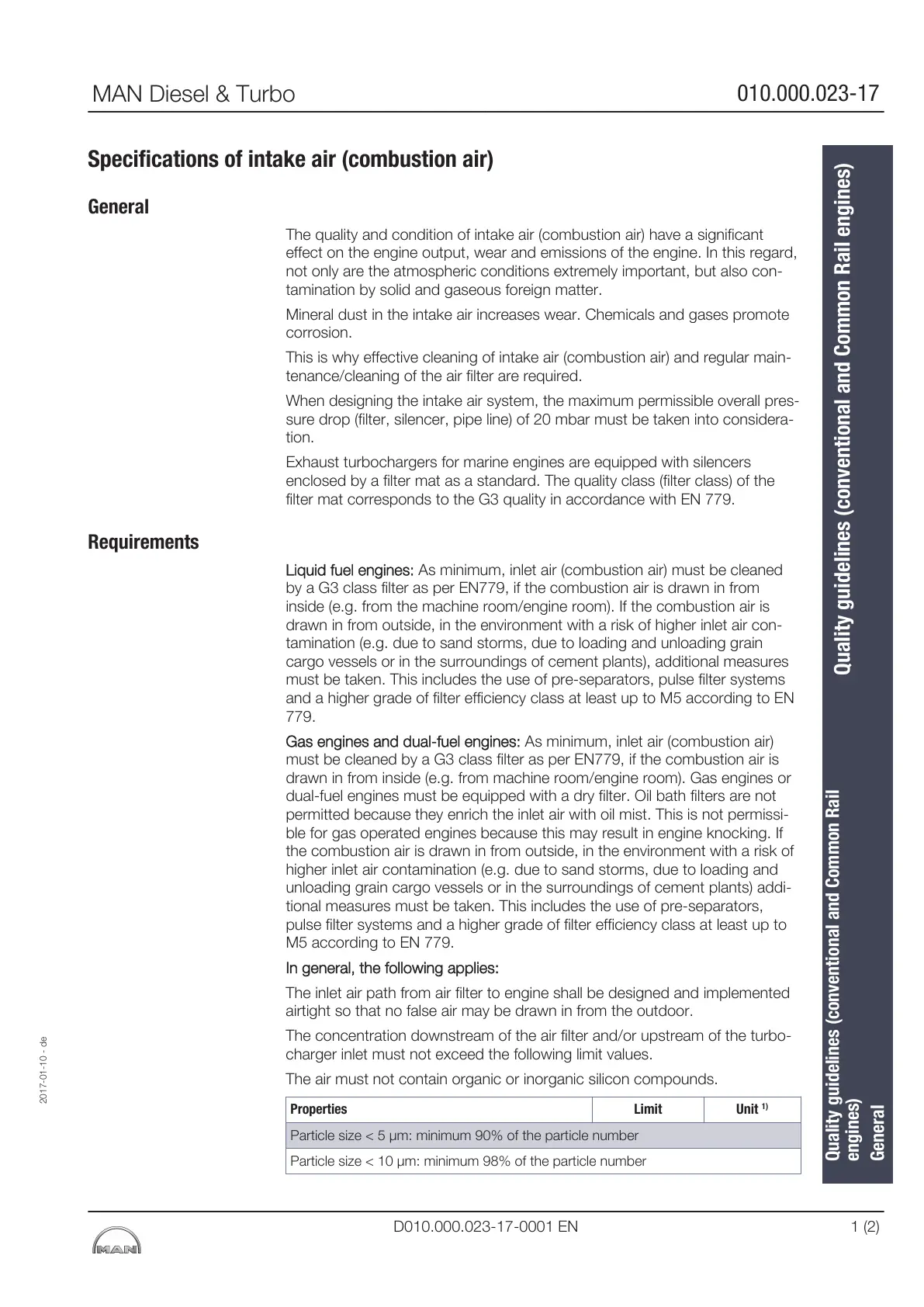Specifications of intake air (combustion air)
General
The quality and condition of intake air (combustion air) have a significant
effect on the engine output, wear and emissions of the engine. In this regard,
not only are the atmospheric conditions extremely important, but also con-
tamination by solid and gaseous foreign matter.
Mineral dust in the intake air increases wear. Chemicals and gases promote
corrosion.
This is why effective cleaning of intake air (combustion air) and regular main-
tenance/cleaning of the air filter are required.
When designing the intake air system, the maximum permissible overall pres-
sure drop (filter, silencer, pipe line) of 20 mbar must be taken into considera-
tion.
Exhaust turbochargers for marine engines are equipped with silencers
enclosed by a filter mat as a standard. The quality class (filter class) of the
filter mat corresponds to the G3 quality in accordance with EN 779.
Requirements
Liquid fuel engines: As minimum, inlet air (combustion air) must be cleaned
by a G3 class filter as per EN779, if the combustion air is drawn in from
inside (e.g. from the machine room/engine room). If the combustion air is
drawn in from outside, in the environment with a risk of higher inlet air con-
tamination (e.g. due to sand storms, due to loading and unloading grain
cargo vessels or in the surroundings of cement plants), additional measures
must be taken. This includes the use of pre-separators, pulse filter systems
and a higher grade of filter efficiency class at least up to M5 according to EN
779.
Gas engines and dual-fuel engines: As minimum, inlet air (combustion air)
must be cleaned by a G3 class filter as per EN779, if the combustion air is
drawn in from inside (e.g. from machine room/engine room). Gas engines or
dual-fuel engines must be equipped with a dry filter. Oil bath filters are not
permitted because they enrich the inlet air with oil mist. This is not permissi-
ble for gas operated engines because this may result in engine knocking. If
the combustion air is drawn in from outside, in the environment with a risk of
higher inlet air contamination (e.g. due to sand storms, due to loading and
unloading grain cargo vessels or in the surroundings of cement plants) addi-
tional measures must be taken. This includes the use of pre-separators,
pulse filter systems and a higher grade of filter efficiency class at least up to
M5 according to EN 779.
In general, the following applies:
The inlet air path from air filter to engine shall be designed and implemented
airtight so that no false air may be drawn in from the outdoor.
The concentration downstream of the air filter and/or upstream of the turbo-
charger inlet must not exceed the following limit values.
The air must not contain organic or inorganic silicon compounds.
Properties Limit Unit
1)
Particle size < 5 µm: minimum 90% of the particle number
Particle size < 10 µm: minimum 98% of the particle number
2017-01-10 - de
Quality guidelines (conventional and Common Rail
engines)
Quality guidelines (conventional and Common Rail engines)
General
MAN Diesel & Turbo
010.000.023-17
D010.000.023-17-0001 EN 1 (2)

